Addressing the concern of dogs drinking pool water is not just a matter of curiosity but a vital aspect of responsible pet care. The potential risks involved in this behavior can range from mild discomfort to severe health consequences.
As pet owners, understanding the circumstances under which pool water consumption is acceptable and when intervention is necessary is crucial. By delving into the nuances of this topic, pet owners can equip themselves with the knowledge needed to ensure their furry companions' well-being.
Key Takeaways
- Small amounts of well-maintained pool water are generally safe for dogs to ingest while swimming.
- Excessive chlorine or unbalanced pool chemicals can harm dogs if consumed deliberately.
- Watch for signs of illness if dogs drink pool water; offer fresh water and monitor closely.
- Immediate veterinary attention is crucial if dogs show severe symptoms or ingest large amounts of pool water.
Understanding Pool Water Ingestion
Understanding the consequences of pool water ingestion is crucial for safeguarding the well-being of dogs who may come into contact with pool environments. While dogs may inadvertently swallow small amounts of pool water while swimming, deliberate consumption can pose risks.
Excessive chlorine intake can irritate the mouth, esophagus, and stomach of dogs. Moreover, unbalanced pool water may contain harmful bacteria, parasites, and pollutants, leading to various health issues. Therefore, maintaining proper pool chemistry with chlorine levels up to 4 milligrams per liter is essential for pet safety.
Regular pH checks and chemical treatments are necessary to ensure that pool water remains safe for dogs to prevent any potential harm from ingestion.
Harmful Effects of Chemical Exposure
Exposure to high levels of chemicals in pool water can have detrimental effects on dogs' health, necessitating a thorough examination of the potential risks associated with such exposure.
The harmful effects of chemical exposure in pool water include:
- Skin Irritation: Chemicals like chlorine can cause skin irritation and dryness in dogs.
- Respiratory Issues: Inhaling chemical fumes from pool water can lead to respiratory problems.
- Gastrointestinal Distress: Ingesting excessive chemicals can result in stomach upset and vomiting.
- Neurological Symptoms: High chemical exposure may cause neurological symptoms like dizziness or confusion in dogs.
It's crucial to monitor dogs closely for any signs of these effects and intervene promptly to prevent further harm.
Risks of Chlorine Overconsumption
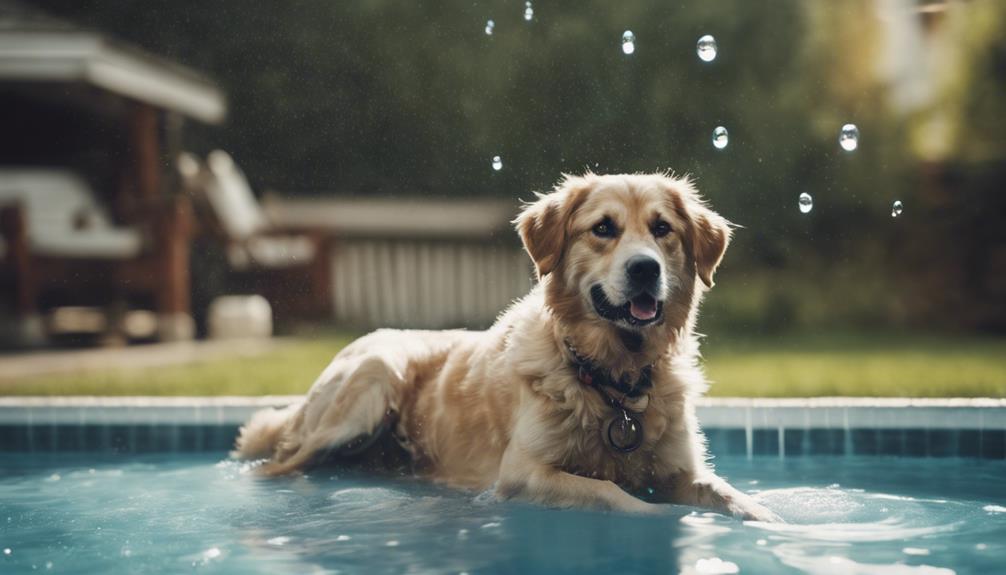
Excessive ingestion of chlorine presents significant health risks for dogs using pools, necessitating a careful balance in maintaining water safety for canine swimmers. Dogs that consume high levels of chlorine from pool water may experience irritation in their mouth, esophagus, and stomach. This can lead to symptoms such as drooling, vomiting, or difficulty swallowing.
Severe cases of chlorine overconsumption can result in gastrointestinal upset, respiratory issues, and in extreme cases, organ damage. It is crucial for pet owners to monitor their dogs' behavior around pool areas and ensure that chlorine levels are within the recommended range to prevent potential health complications.
Regular veterinary check-ups can help in identifying any chlorine-related health concerns early on.
Pool Water Contamination Concerns
Given the importance of maintaining water safety for canine swimmers, vigilance regarding pool water contamination is paramount to safeguarding dogs' health and well-being.
Pool Water Contamination Concerns:
- Bacteria and Parasites: Stagnant pool water can harbor harmful bacteria and parasites, leading to infections in dogs.
- Chemical Imbalances: Incorrect chemical levels in pool water can cause skin irritation, eye problems, and gastrointestinal issues for dogs.
- Debris and Pollutants: Leaves, insects, and other debris can contaminate pool water, posing a risk to dogs if ingested.
- Algae Growth: Algae growth in pool water can be toxic to dogs, causing symptoms like vomiting, diarrhea, and lethargy.
Importance of Proper Pool Maintenance
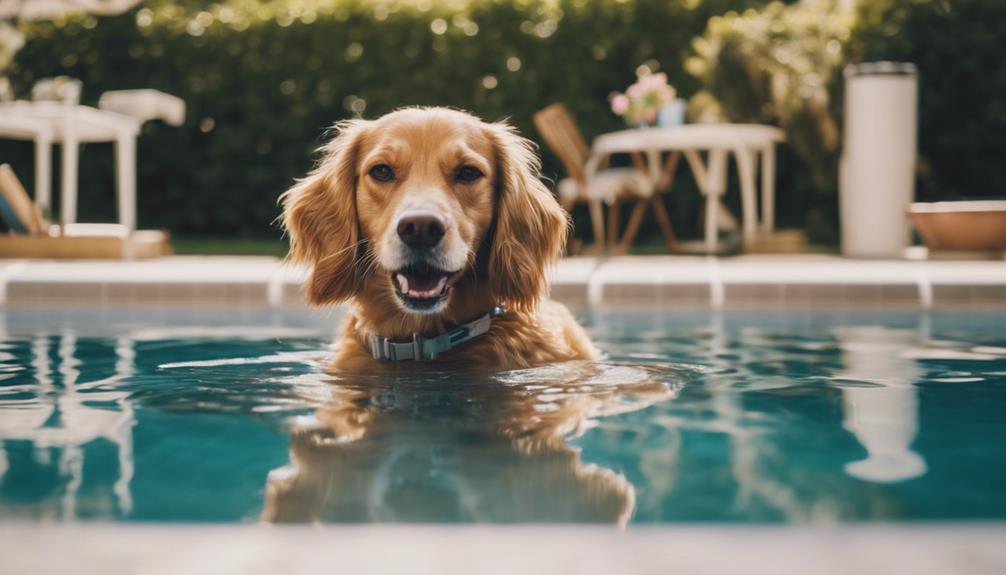
Maintaining proper pool hygiene is essential for ensuring the safety and well-being of dogs enjoying aquatic activities. Regular pool maintenance, including monitoring chlorine levels up to 4 milligrams per liter and conducting frequent pH checks, is crucial to prevent the buildup of harmful substances.
Proper pool sanitation not only safeguards against bacteria, parasites, and pollutants but also ensures that dogs are not exposed to excessive chlorine levels that can lead to irritation and gastrointestinal issues. By keeping the pool water clean and balanced, pet owners can create a safer environment for their furry companions to swim and play.
Investing time and effort into pool maintenance is key to promoting a healthy and enjoyable swimming experience for dogs.
Impact of Chloramines on Dogs
The presence of chloramines in pool water can have adverse effects on dogs' health and well-being, necessitating careful consideration in maintaining a safe swimming environment for canine companions.
Impact of Chloramines on Dogs:
- Respiratory Irritation: Dogs can experience respiratory issues like coughing and wheezing when exposed to chloramines.
- Skin and Eye Irritation: Chloramines can cause skin dryness, itchiness, and eye irritation in dogs.
- Digestive Problems: Ingesting chloramines through pool water can lead to gastrointestinal upset and discomfort in dogs.
- Overall Health Concerns: Prolonged exposure to chloramines may impact dogs' immune systems and overall well-being, emphasizing the need for vigilant pool maintenance to minimize risks.
Health Risks in Saltwater Pools
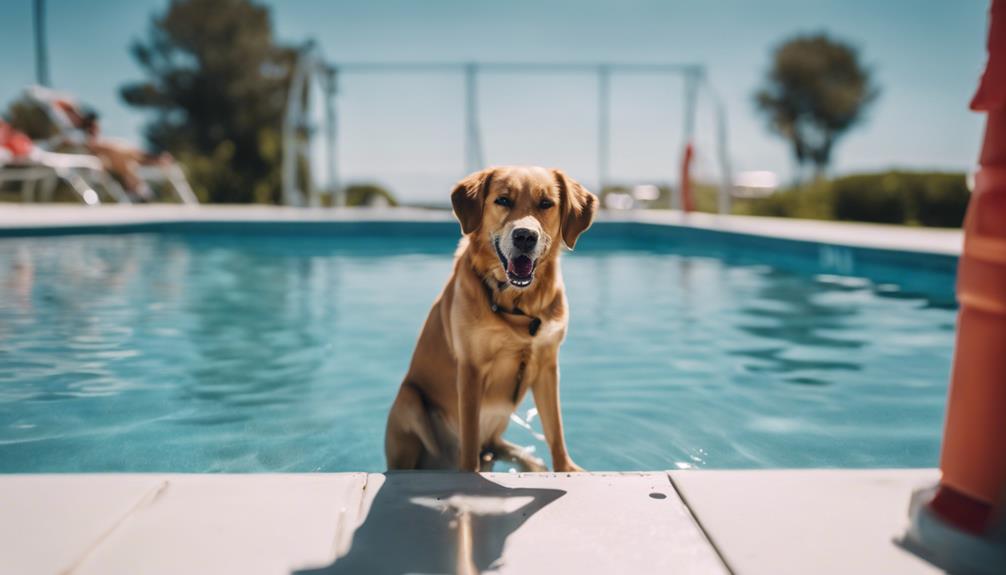
Health risks associated with saltwater pools for dogs include potential electrolyte imbalances and skin irritation due to salt ingestion. Dogs may be attracted to saltwater pools, but consuming large amounts of saltwater can lead to health issues. Here is a breakdown of the main health risks in saltwater pools for dogs:
| Health Risk | Description | Prevention |
|---|---|---|
| Electrolyte Imbalances | Excessive salt intake can disrupt electrolyte balance, leading to dehydration and health problems. | Provide fresh water regularly |
| Skin Irritation | Saltwater ingestion can cause skin irritation, dryness, and coat issues in dogs. | Rinse dogs thoroughly after swimming |
Supervision and Maintenance Importance
Ensuring diligent supervision and meticulous maintenance practices are fundamental for safeguarding dogs' well-being around pool areas. It is essential to prioritize safety measures to prevent any potential hazards that could arise from dogs interacting with pool water.
Here are four key points to consider:
- Regular Supervision: Always keep a close eye on your dog while they are near the pool to prevent any unwanted incidents.
- Proper Fencing: Install secure fencing around the pool area to restrict access and ensure dogs cannot enter unsupervised.
- Routine Maintenance: Regularly check and maintain pool water quality to avoid any harmful imbalances that could affect your dog's health.
- Immediate Clean-Up: Promptly clean up any spills of pool chemicals or debris to prevent accidental ingestion or skin contact.
Preventing Skin and Coat Issues
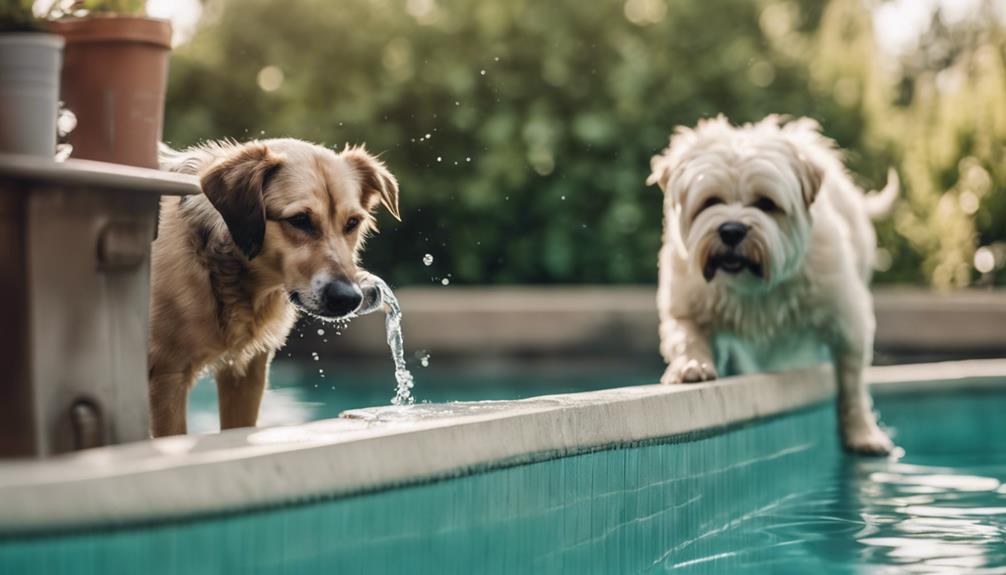
Implementing proper rinsing techniques after dogs swim in pools can effectively prevent skin and coat issues associated with pool water exposure. Rinsing removes chlorine, salt, and other chemicals that can cause dryness, irritation, or allergic reactions in dogs. Here is a table detailing key tips to prevent skin and coat problems post-swim:
| Prevention Tips | Description | Benefits |
|---|---|---|
| Rinse with Fresh Water | Thoroughly rinse your dog with clean water after swimming to remove pool chemicals. | Prevents skin irritation and coat dryness. |
| Use Dog-Friendly Shampoo | Wash your dog with a mild, dog-specific shampoo to remove any remaining pool residues. | Maintains a healthy coat and skin. |
| Check for Skin Irritation | Inspect your dog's skin for any redness, itchiness, or dry patches post-swim. | Early detection and treatment of skin issues. |
| Monitor Coat Condition Regularly | Keep an eye on your dog's coat texture and shine to identify any changes that may indicate skin problems. | Promotes overall skin and coat health. |
Recognizing Water Intoxication Signs
After ensuring your dog's skin and coat are properly cared for post-swim, it is crucial to be vigilant in recognizing signs of water intoxication to safeguard your pet's well-being. Here are some key signs to watch for:
- Excessive drooling or foaming at the mouth.
- Lethargy or weakness.
- Vomiting or nausea.
- Loss of coordination or difficulty walking.
If you notice any of these symptoms after your dog has been swimming and potentially ingesting pool water, it is essential to seek veterinary attention promptly. Recognizing these signs early can help prevent serious complications associated with water intoxication and ensure your dog's health and safety.
Prevention Strategies for Water Intoxication
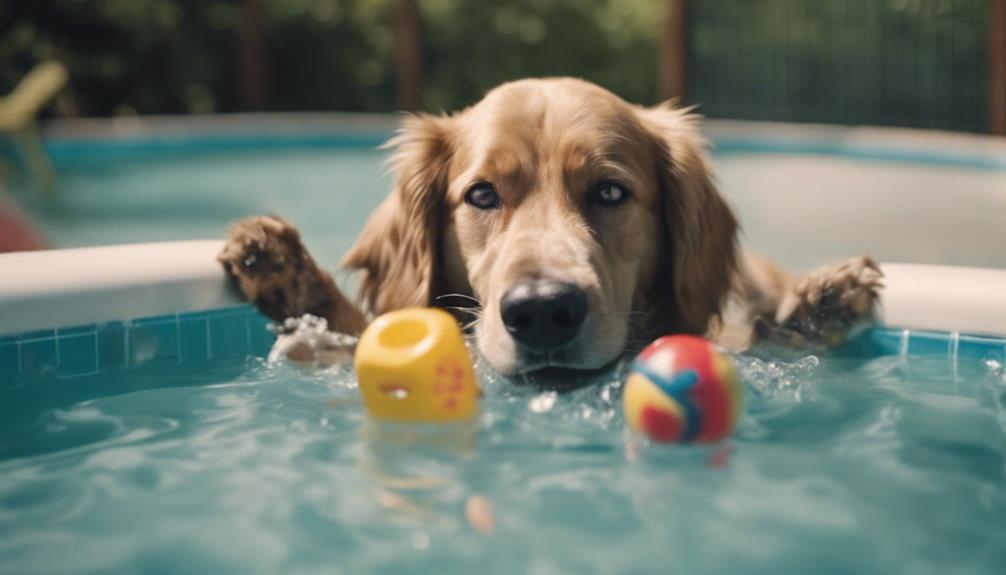
To mitigate the risk of water intoxication in dogs, diligent supervision during water activities is paramount. Along with supervision, implementing preventive measures can help safeguard your furry friend. Below is a table outlining effective prevention strategies for water intoxication:
| Prevention Strategies | Description | Benefits |
|---|---|---|
| Limit Water Access | Control access to large bodies of water | Reduces the chances of overconsumption |
| Provide Regular Breaks | Encourage rest periods during playtime | Prevents excessive water intake |
| Offer Fresh Water Regularly | Ensure access to clean water to drink | Helps maintain hydration levels |
| Avoid High-Intensity Play | Moderate play to prevent excessive water ingestion | Reduces the risk of water intoxication |
| Monitor Behavior Closely | Watch for signs of fatigue or excessive drinking | Enables prompt intervention if needed |
Cooling Techniques on Hot Days
On scorching summer days, ensuring proper cooling techniques for dogs is vital to prevent heat-related issues. Here are some effective ways to keep your furry friend cool and comfortable:
- Provide access to shade and fresh water at all times.
- Use cooling mats or vests to help lower your dog's body temperature.
- Limit outdoor activities to early mornings or evenings when temperatures are cooler.
- Offer frozen treats or ice cubes for a refreshing cooldown.
Ensuring Safety in Dog Swimming
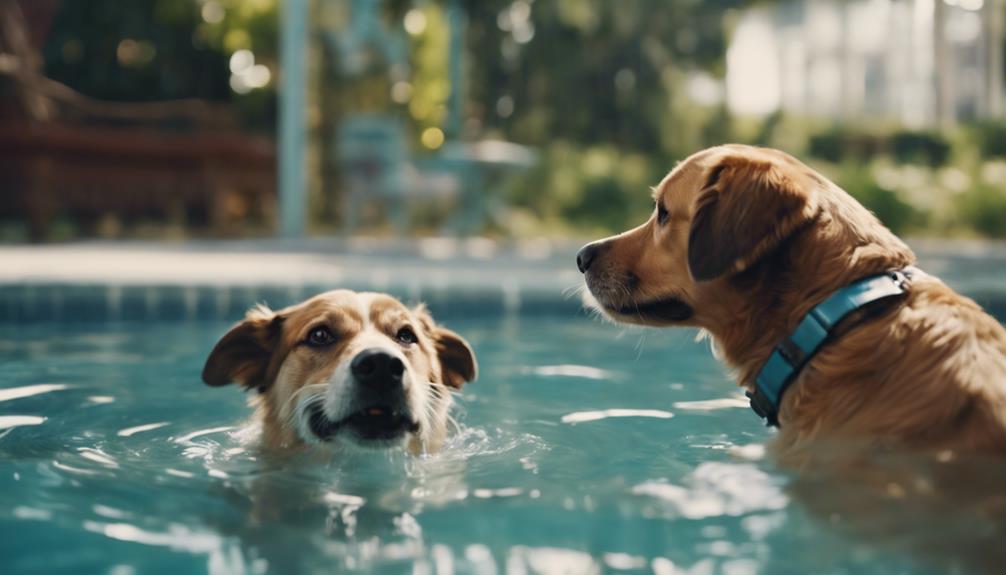
Ensuring the safety of dogs while swimming requires vigilant supervision and adherence to proper pool maintenance practices. One way to enhance safety is by implementing the following measures:
| Safety Measure | Description | Importance |
|---|---|---|
| Supervision | Continuous monitoring of dogs while they swim to prevent accidents | Critical |
| Pool Maintenance | Regularly check chlorine levels and pH balance to ensure safe swimming conditions | Essential |
| Pet Life Jacket | Ensure dogs wear a properly fitted life jacket for added buoyancy and safety | Recommended |
Post-Swim Skin Care Tips
After a dog has finished swimming, how can owners ensure proper care for their pet's skin to prevent dryness and irritation?
- Rinse Thoroughly: Rinse your dog with fresh water to remove any chlorine or salt residue.
- Dry Gently: Pat your dog dry with a towel to prevent skin irritation from excess moisture.
- Moisturize: Apply a dog-friendly moisturizer to hydrate the skin and prevent dryness.
- Check for Irritation: Inspect your dog's skin for any redness, itching, or irritation and consult a vet if needed.
Following these post-swim skin care tips can help maintain your dog's skin health and comfort after a swim.
Steps to Take After Pool Water Ingestion
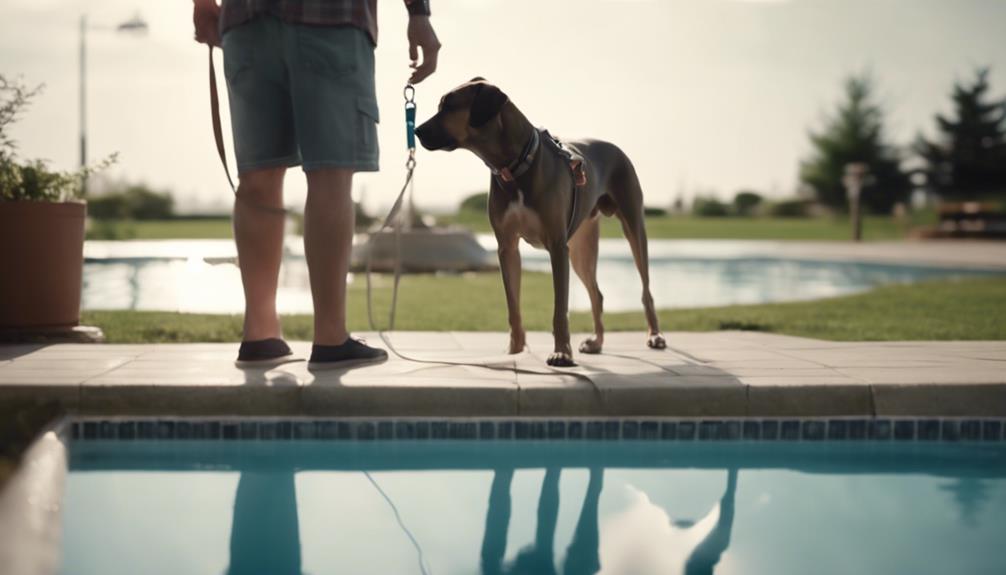
Following a dog's ingestion of pool water, it is essential to promptly assess any concerning symptoms and take appropriate action to safeguard the pet's well-being. If your dog has consumed pool water and you notice any abnormal behavior or signs of distress, consider the following steps:
| Step | Action | Reason |
|---|---|---|
| Monitor Symptoms | Watch for vomiting, diarrhea, lethargy, or excessive thirst | Indicates potential issues from pool water |
| Offer Fresh Water | Provide clean water to prevent dehydration | Dilutes any chemicals ingested and aids flushing |
| Contact Vet if Concerned | Seek professional advice if symptoms persist or worsen | Ensures proper treatment for the dog's well-being |
Taking these steps can help mitigate any potential harmful effects of pool water ingestion on your dog's health and well-being.
Conclusion
In conclusion, responsible pet ownership entails being mindful of the potential risks associated with dogs drinking pool water. Understanding the harmful effects of chemical exposure, risks of chlorine overconsumption, and the importance of proper pool maintenance are crucial in ensuring the safety of our canine companions.
By implementing preventive measures and recognizing concerning symptoms, pet owners can protect their beloved pets from the dangers of pool water ingestion and promote their overall well-being.




